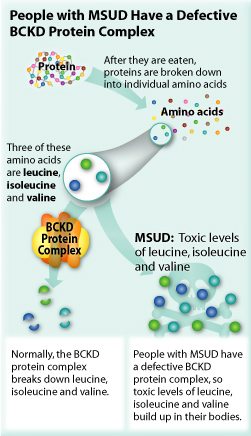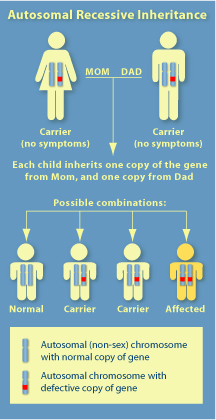Maple Syrup Urine Disease (MSUD)
Maple Syrup Urine Disorder (MSUD) also known as BCKD deficiency, Branched-chain alpha-keto acid dehydrogenase deficiency, and Branched-Chain Ketoaciduria Ketoacidemia is an inherited disorder in which the body is unable to process certain amino acids (protein building blocks) properly. The disease appears at infancy and may be lethal if proper precautions are not taken. Discovered by John Menkes in 1954, this disorder affects one in every 185,000 newborns. MSUD is characterized by sweet smelling, low viscosity urine. This disease is carried throughout ones entire lifetime. The three forms of MSUD run from mild to extreme and can cause everything from a slight annoyance to comas and brain damage.
History
The disease was discovered in 1954 by Dr. John Menkes. Menkes reported a family that had four infants die within the first three months of life. The oddity is that all of the dead infants had urine that smelled like maple syrup, thus the name Maple Syrup Urine Disorder came to be. In 1960 Dr. J. Dancis found that in branched-chain amino acids and their corresponding alpha-keto acids there were pathogenetic compounds. He found an enzymatic defect in MSUD was at the level of the decarboxylation of the branched-chain amino acids. Around this time SE Snyderman came up with the first diet that could positively affect MSUD by decreasing the intake of branched-chain amino acids. In 1971, Scriver reported the first case of thiamine-responsive MSUD. The branched-chain alpha-keto acid dehydrogenase (BCKD) complex was purified and characterized in 1978.
Symptoms
Maple Syrup Urine Disease is classified by its pattern of signs and symptoms, which become apparent within three to four days after birth. These symptoms include: loss of appetite, fussiness, and sweet-smelling urine. There is a classic form of MSUD and several less common forms, each varying in its severity and characteristic features. The classic signs and symptoms include; developmental delay, avoiding food, coma, feeding difficultly, lethargy, seizures, urine that smells like maple syrup, and vomiting. If a child with MSUD is not treated, life threatening metabolic crisis can occur. It may cause damage to the brain resulting in mental retardation, and may present seizures, coma, and death within the first few months of life. Children diagnosed early before severe symptoms appear have a chance for normal intelligence with strict diet care. [1][2]
Mechanisms
The underlying mechanism causing Maple Syrup Urine Disease is based on the mutations in BCKA, BCKDHA, DBT, and DLD genes. These genes are responsible for making the enzymes called 2-oxoisovalerate dehydrogenase alpha, 2-oxoisovalerate dehydrogenase beta, and lipoamide acyltransferase. These genes also provide the information for making the protein complex essential for breaking down the amino acids leucine, isoleucine, and valine. Defects in any of the six subunits that make up the BCKD protein complex can cause the development of MSUD. The most common defect is caused by a mutation in a gene on chromosome 19 that encodes the alpha subunit of the BCKD complex (BCKDHA). The mutations of these genes reduce and or eliminate their function preventing the normal breakdown of the amino acids. Since they are not being broken down they accumulate in the urine, along with their metabolites (alpha-ketoacids) to give the distinctive sweet smelling urine common in those with MSUD. The build up of the amino acids and their by-products, along with accumulation in urine, also build up in the blood causing high levels of these substances which can then become toxic to the brain as well as other organs. These high levels lead to the serious medical problems and symptoms association with maple syrup urine disease. If the symptoms go left untreated they may end up with dangerously high levels of these amino acids in their blood, causing the rapid degeneration of brain cells and even death. [1] [3] [4] [5]
en. Google Images(Accessed on Nov 30,2009)
Treatments
Since MDSU is a genetic disorder, new strives are being taken to detect the disease early on. A new screening type can uses tandem mass spectrometry (MS/MS) for screening newborns for various inherited diseases, one of which is MSUD. The screening process can detect the presence of the disease; however, it is still questionable how cost effective the screening is. This new screening can detect the incidence of each disease at birth, the severity of disease, the responsiveness to treatment, accuracy (sensitivity, specificity and positive predictive rates) of screening for all different metabolic disorders, and mortality. The next step for the disease is to make AAAs on site or even mobile. Like the disorder, Diabetes, MSUD needs to be monitored throughout the day. As of now the only way to keep track of the amount amino acids in a patient’s body is by using an Amino Acid Analyzer (AAA) which are located in very few hospitals. The Amino Acid Analyzer is a piece of equipment that will enable better care for patients who have metabolic conditions involving protein metabolism. These disorders include Phenylketonuria (PKU), Maple Syrup Urine Disease (MSUD), Urea Cycle Disorders (UCD), and more. The machines run about 85,000 dollars to make, and cost increases with use and employees to run it. So steps are being taken to “shrink” the AAA and make it more cost efficient so sufferers of MSUD can test anywhere like patients of diabetes. Donations to this cause can be made at MSUDresearchfoundation.org . [6]
Current Research
Since the disorder is more genetic new strives are being taken to detect the disease early on. A new screening type can use the use of tandem mass spectrometry (MS/MS) for screening newborns for inherited diseases one of which is MSUD. The screening can detect the presence, however, it is still questionable how cost effective the screening is. This new screening can detect the incidence of each disease at birth, the severity of disease, the responsiveness to treatment, accuracy (sensitivity, specificity and positive predictive rates) of screening for all different metabolic disorders, and mortality. There are also three large grants out from the NIH to study MSUD but no information has been released on any new positive outcomes. [7]
Outlooks
There is no cure for MSUD and even when the strict diet treatment regiment is fallowed stress may cause a sudden rise in amino acids and cause coma, neurological damage, and even death. (This can also be brought on by sudden or severe illness.)
Despite MSUD’s devastating effects children with MSUD have still grown up into healthy adults and productive members of society. [1]
References
[1] Maple Syrup Urine Disease (MSUD). 2005 < http://www.utmem.edu/bcdd/services/programs/iem_pdf/MSUD.pdf >
[2] Maple Syrup Urine Disease. 2009. < http://learn.genetics.utah.edu/content/disorders/whataregd/msud/>
[3] Maple Syrup Urine Disease. 2008. <http://ghr.nlm.nih.gov/condition=maplesyrupurinedisease>
[4] Genes and Disease. Maple Syrup Urine Disease. 2007 <http://www.ncbi.nlm.nih.gov/bookshelf/br.fcgi?book=gnd&part=maplesyrupurinedisease>
[5] Medline Plus. Maple Syrup Urine Diease. 2009 <http://emedicine.medscape.com/article/946234-overview>
[6] National Organization for Rare Disorders. 2007. Maple Syrup Urine disease. <http://www.rarediseases.org/search/rdbdetail_abstract.html?disname=Maple%20Syrup%20Urine%20Disease>
[7]Centre for Reviews and Dissemination. 2007. NHS Economic Evaluation Database (NHS EED). <http://www.crd.york.ac.uk/CRDWeb/ShowRecord.asp?View=Full&ID=22007000705>


